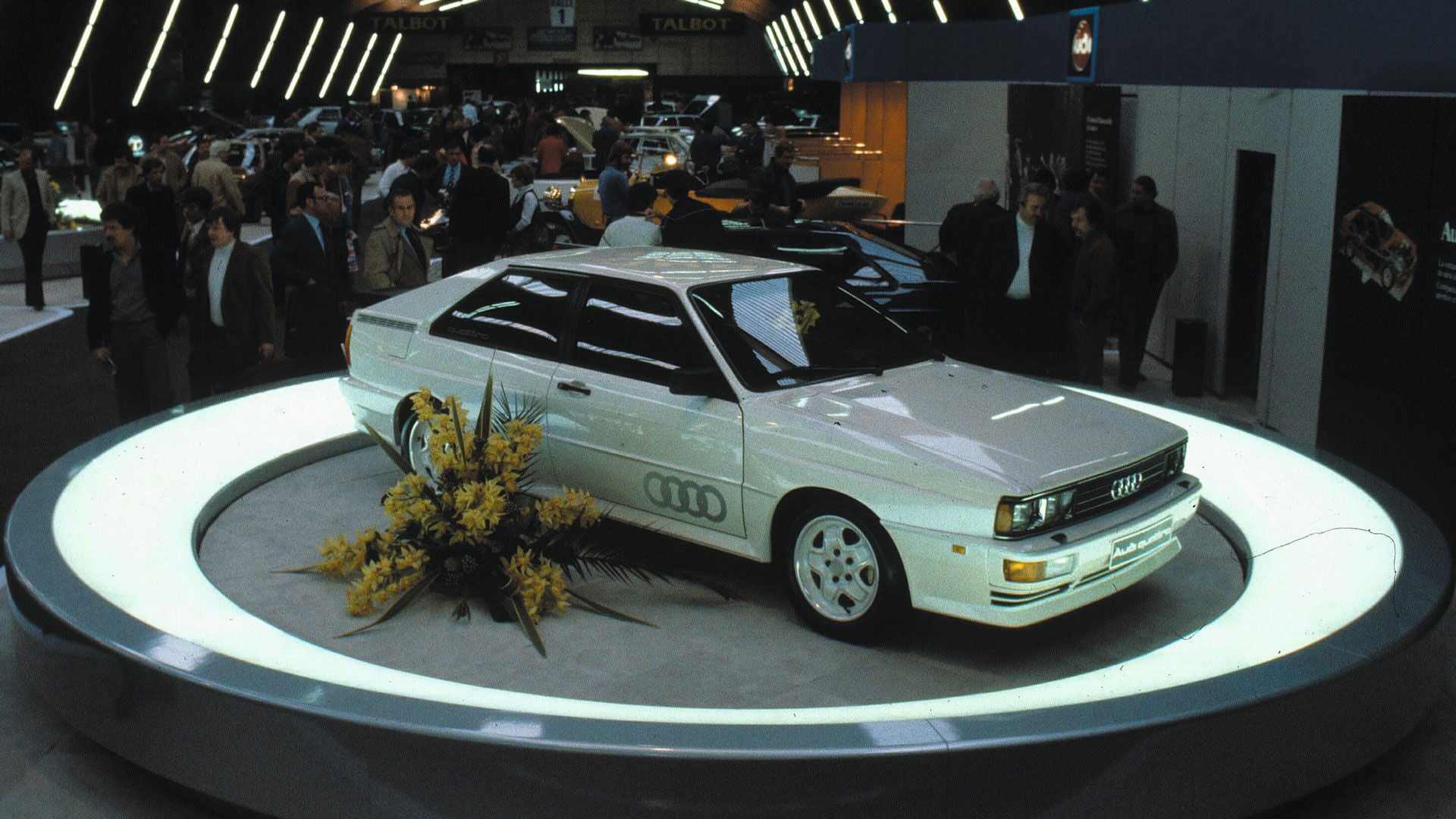The history of AUDI AG

The founding – the first chapter of a great story
The eventful history of Audi began in the 19th century, with the first chapter written by August Horch, one of the German pioneers of automotive engineering. After graduating from the Technical Academy in Mittweida, Saxony, he initially worked in engine construction and later as operations manager in motor vehicle production at the Carl Benz company in Mannheim. On 14 November 1899, with the establishment of the company A. Horch & Cie. in Cologne, he laid the foundation for what would become a world-famous brand.
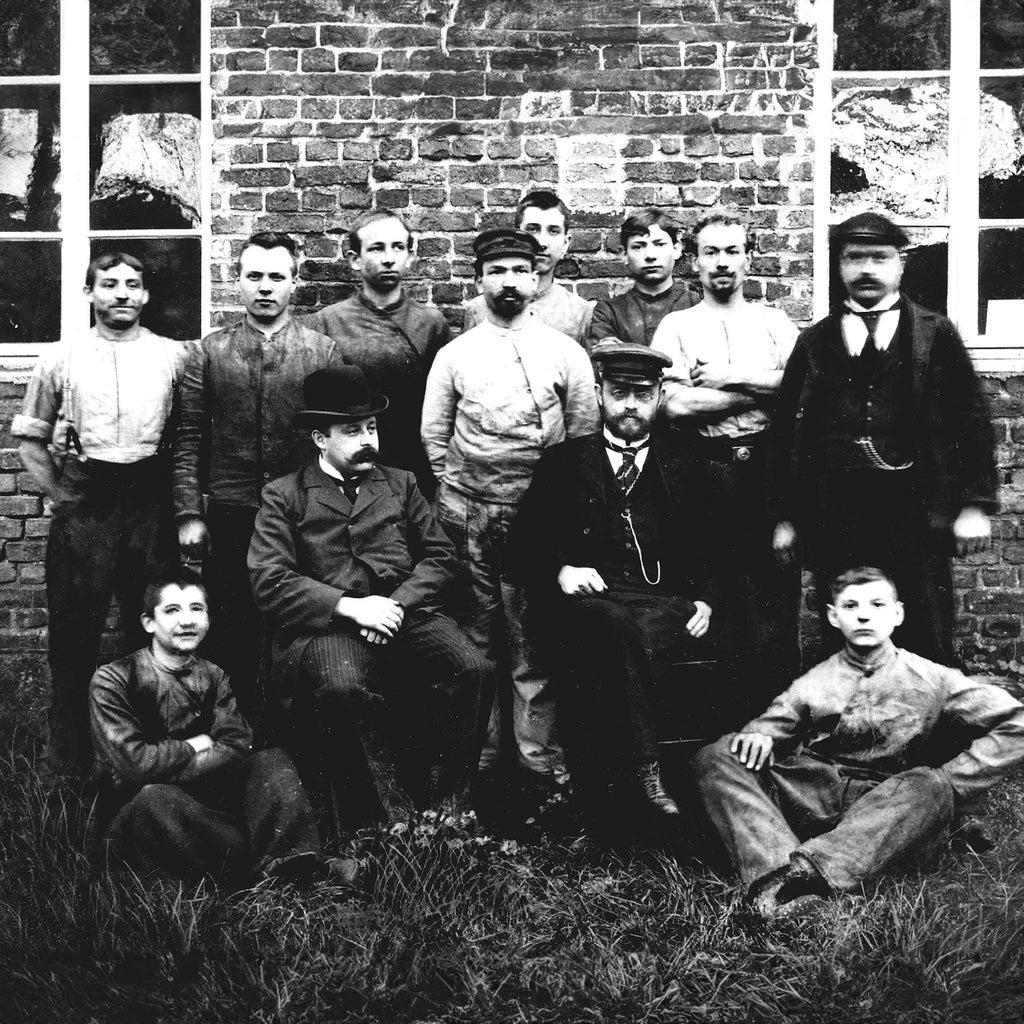
The first employees of A. Horch & Cie. in Cologne, with August Horch seated on the chair in the middle.
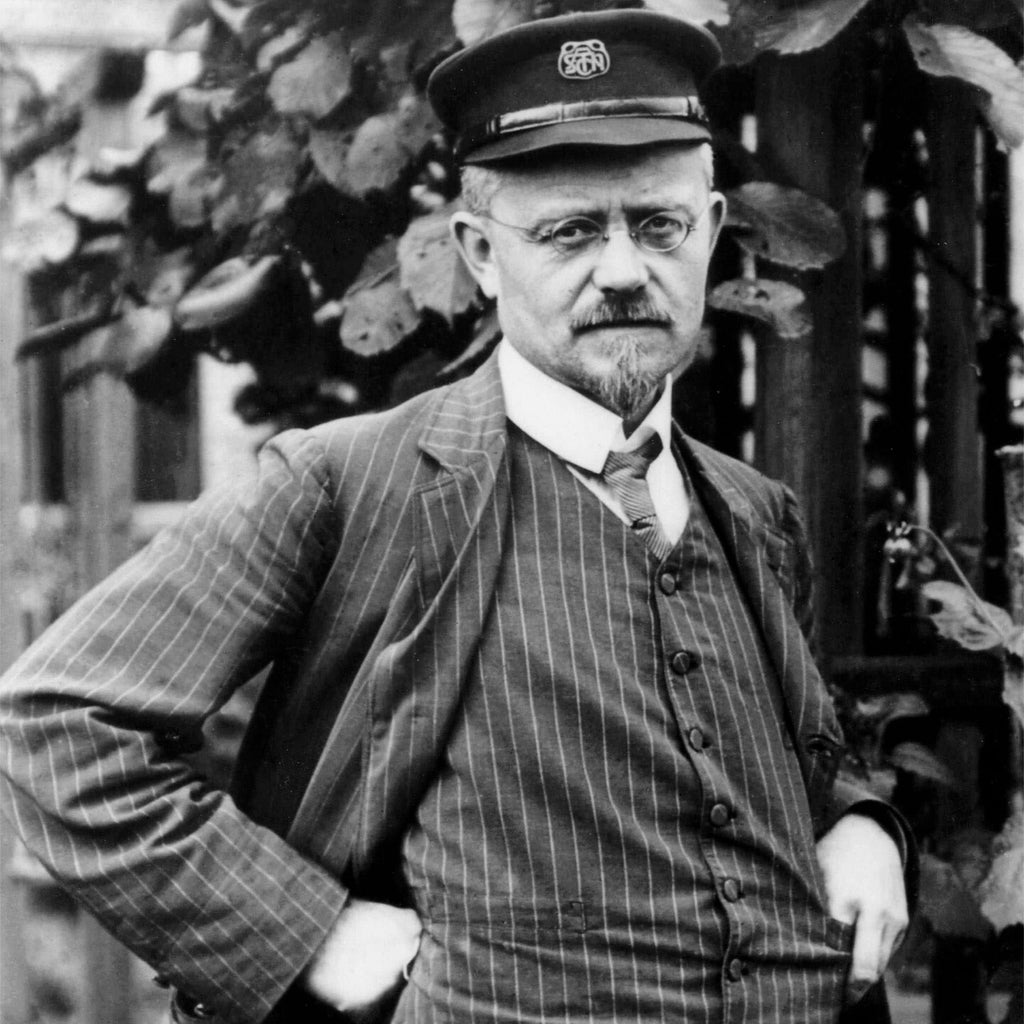
Founder August Horch, pictured here in 1905.
The first employees of A. Horch & Cie. in Cologne, with August Horch seated on the chair in the middle.
Founder August Horch, pictured here in 1905.
A second chance – from Horch to Audi
In 1902, Horch relocated his company to Reichenbach in Saxony. And in 1904, he registered it as a joint-stock company and moved to Zwickau. However, just five years later, he left the company due to differences of opinion and founded a new car company. Because he was not allowed to use his own name again, it was translated into Latin. The idea of using the imperative form of the Latin word for “to hear” – that is, “Audi!” which in German would be “Horch!” – is said to have come from the son of a business partner who was listening in on the quest for a new name while doing his homework.

The workforce of the company

Symbolic meaning – Four rings for four brands
On 29 June 1932, on the initiative of Saxony’s state bank, the companies Audi, DKW and Horch as well as the automotive division of Wanderer Werke merged to form Auto Union AG – thus creating the second largest automotive group in Germany. The allies were thus able to face financial challenges together.The company logo – four interlocking rings – is world-famous to this day and symbolises the unity of the four founding companies. Each of the four brands is associated with a specific vehicle segment.
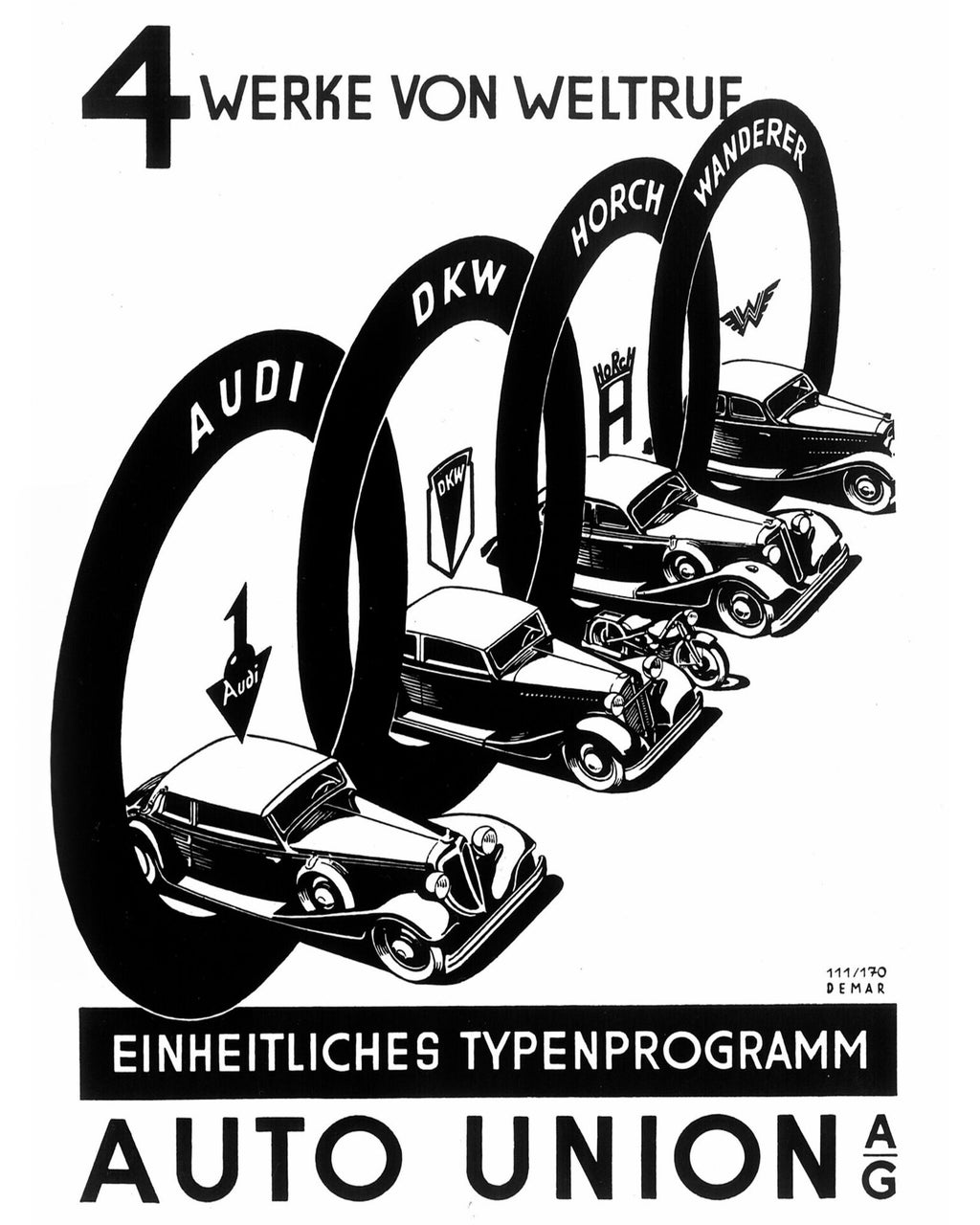
A newspaper ad run by Auto Union to mark the merger in 1932.
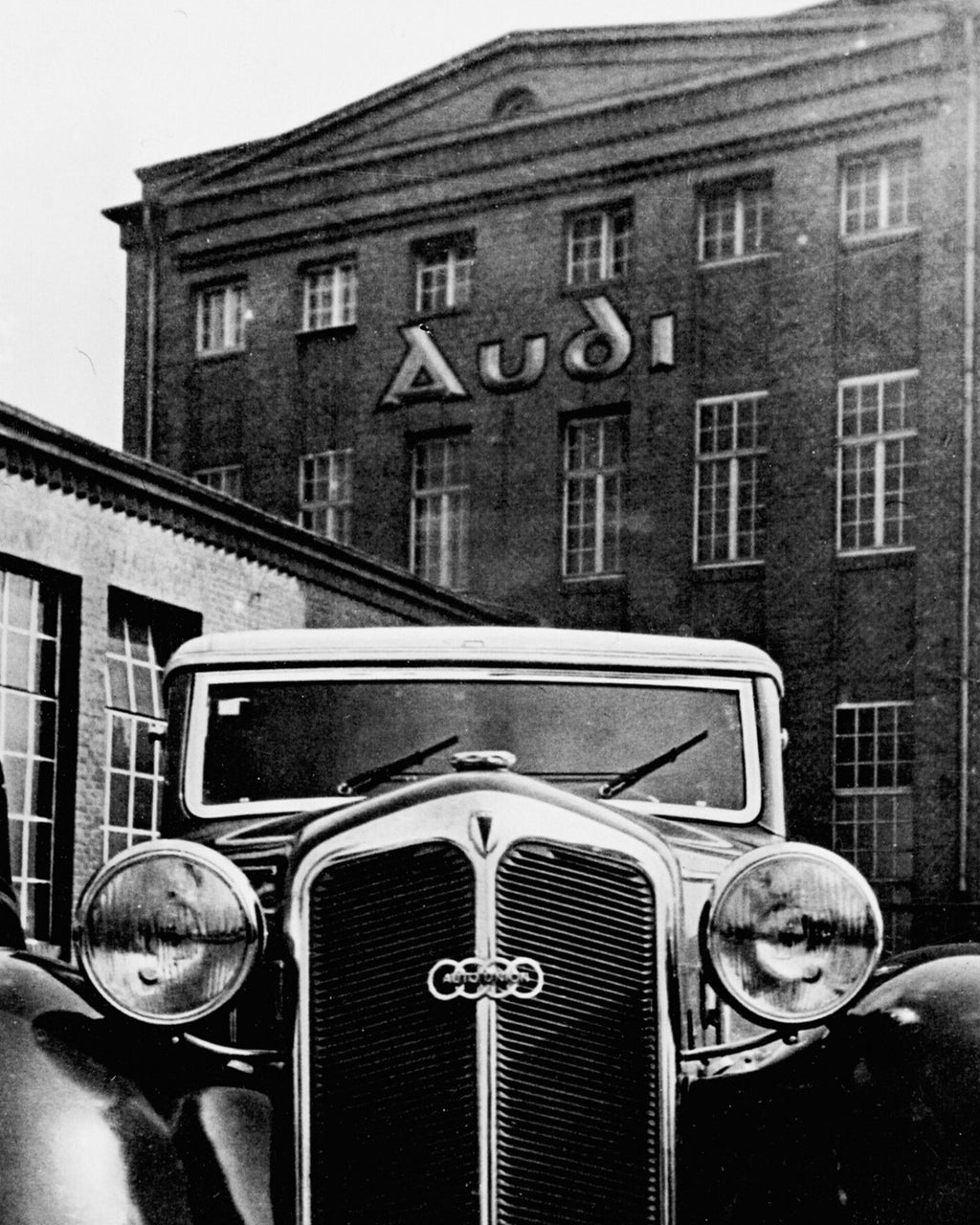
A DKW F 5 sporting the Auto Union logo in front of the Audi plant in Zwickau.
A newspaper ad run by Auto Union to mark the merger in 1932.
A DKW F 5 sporting the Auto Union logo in front of the Audi plant in Zwickau.

The four brands of Auto Union
Synergies – the advantages of the union
One of the reasons why Auto Union, despite its youth, achieved such success was its strategic decision to assign the individual brands to a specific market segment, thus enabling the Group to present a coordinated range of models. This allowed the brands to share components and production resources, which in turn brought economic advantages.

Showrooms at Capitol am Zoo in Berlin featuring the four Auto Union brands in 1937.
More Details
The strength of Auto Union lay in the fact that each brand was able to contribute expertise in its own specialist field. This is how the Audi Front Type UW came about, for example. Its most important feature was, of course, its front-wheel drive. Here, some of DKW’s front-wheel drive experience was transferred to a mid-range vehicle. The car was powered by a 2-litre six-cylinder engine from Wanderer, with the saloon’s body coming from the Horch body shop, while the cabriolets were supplied by renowned body manufacturer Gläser from Dresden.
The successor model, the Audi 920, also featured technical components from the other brands. Its chassis, now back to conventional rear-wheel drive, was essentially the same as that of the Wanderer W 23, as was its modern body design. This elegant car came with a straight-six OHC engine developed by Horch, whereas the rear axle was constructed along the lines of the DKW floating axle principle. The first specimens of the new model rolled off the Horch production line in December 1938, quickly establishing themselves on the market.

Motorsport – successes and records
Motorsport played a part in the company’s history from the very beginning. The first success dates back to 1906, when the Horch 11/22 PS won the Herkomer Competition. Audi achieved further successes with its Audi Type C, winning the Austrian Alpine Rally between 1912 and 1914. Wishing to demonstrate the vehicles’ reliability and raise awareness of its new name Auto Union in the 1930s, the company became involved in motorsport from the outset. Still unforgotten today: Auto Union’s competitions with Mercedes-Benz and Bernd Rosemeyer’s record-breaking races.

Bernd Rosemeyer with the Auto Union Type C during the Eifel Race on 13 June 1937 Nürburgring.‘
More Details
In 1933, it concluded an agreement with Ferdinand Porsche for the development of a Grand Prix racing car, which debuted in May 1934 on the Avus circuit in Berlin. The vehicle’s design was unusual in many respects: 16 cylinders in a “V” configuration with a Roots compressor, a mid-mounted engine and a front axle with double trailing arms and torsion bar suspension were unique at the time.
Between 1934 and 1938, the racing car underwent continuous development and its power output was raised from the initial 295 PS (Type A) to 520 PS (Type C). Impressive victories on international racetracks – with stars such as Hans Stuck, Achille Varzi and Bernd Rosemeyer at the wheel – soon made Auto Union, although founded only a short time before, known to the public worldwide. The duels between the Silver Arrows of Mercedes-Benz and Auto Union in the 1930s are legendary.
Equally sensational was the world speed record run on the Frankfurt-Darmstadt ‘autobahn’ in October 1937, with Rosemeyer driving a streamlined Type C and becoming the first person to drive a car on a public motorway at more than 400 kilometres an hour.

The Second World War – a dramatic turning point
Auto Union’s development was brought to an abrupt halt by the outbreak of the Second World War in 1939 and its involvement in the production of armaments and war supplies. Employing around 17,300 forced labourers and 3,700 prisoners from various satellite camps of the Flossenbürg concentration camp, the company was firmly caught up in the Nazi terror regime. After the end of the war, the company was expropriated by the Soviet occupation forces, and its production facilities were largely dismantled. In 1948, Auto Union AG was deleted from the commercial register of the city of Chemnitz.

Female forced labourers in 1942
The end of the war – and a new start in Bavaria
Towards the end of 1945, a number of managers and employees of Auto Union AG, having fled to the West, set up a warehouse for replacement parts in the old garrison town of Ingolstadt. After the cancellation from the commercial register in Chemnitz, on 3 September 1949, Auto Union GmbH was established as a legally independent production company which – now free from its previous associations – began manufacturing DKW brand vans and motorcycles in the same year. And so it was that vehicle construction began in Ingolstadt, utilising empty former military buildings.

Entrance to the head office of Auto Union GmbH in Ingolstadt, which was founded in September 1949.
More Details
The post-war years were a time of great hardship, and people needed simple, robust and reliable cars and motorbikes. That is why the company decided to revive some of DKW’s tried and tested products, with their characteristic two-stroke engines, under the banner of the four rings. Models such as the DKW F 89 L Schnelllaster (a rapid transporter) and the DKW RT 125 W motorbike were developed on the basis of the pre-war vehicles.
At the same time, work was underway on a new passenger car called the DKW F 89 P, which went into production in the summer of 1950 in a factory in Düsseldorf that the company had initially only leased. Slowly but surely, these modest beginnings evolved into a portfolio of motorcycles in various engine capacity classes and passenger cars with two- and three-cylinder two-stroke engines.
Takeover – Auto Union as part of Daimler-Benz
From 1954 onwards, the industrialist Friedrich Flick gradually acquired large parts of the share capital of Auto Union GmbH. His plan was to find a strong partner for the company in the medium term. In April 1958, Daimler-Benz AG took over 88 per cent of the shares, and the following year the Ingolstadt-based company became a wholly-owned subsidiary.

Production of the VW Beetle at the Ingolstadt plant, along with Audi vehicles.
Reincarnation – the Audi brand as part of the Volkswagen Group
As living standards rose at the time of the economic miracle, so did peoples’ expectations – including the expectations they had of their cars and the technology they contained. Auto Union GmbH’s overly long reliance on the two-stroke engine caused the company to fall into a deep crisis. Having failed to turn the company around under Daimler-Benz, it was taken over by Volkswagenwerk AG in 1965. In the same year, the Audi brand – which had been revived after the Second World War in a deliberate attempt at differentiation from DKW – launched its first vehicle with a four-stroke engine that had been developed while still part of Daimler-Benz. This was the turning point in terms of both technology and commercial success. Another milestone was reached in 1968 with the launch of the Audi 100, which heralded a new era. For one thing, it was the first model that was not based in any way on DKW technology, and for another, its market success strengthened the independence of Auto Union within the Volkswagen Group.

Production of VW Beatle in Ingolstadt
More Details
DKW’s refusal to abandon the outdated two-stroke engine, coupled with an unsuccessful model policy, caused its sales figures to fall continuously in the early 1960s. In response to this situation, Daimler-Benz dispatched engineer Ludwig Kraus to Ingolstadt to adapt a four-cylinder four-stroke engine developed in Stuttgart so that it could be used in the DKW F 102 passenger car, which had been launched in 1963.
This new Auto Union model appeared on the market in 1965, the company’s first post-war vehicle with a four-stroke engine. A new era had begun, calling for a new product name – and so the well-established name Audi was resurrected. Auto Union’s Type Audi, initially without any further model designation, was heavily promoted and proved a huge success. The model series based on it, with the internal designation F 103 and a few technical and stylistic modifications, was produced until 1972.
But it was also the beginning of a new era in Ingolstadt in other respects. The company had been part of the Volkswagen Group since 1965. In Wolfsburg, discussions were taking place about using the production capacity in Ingolstadt exclusively for the VW Beetle. The new owner initially barred the subsidiary from developing its own vehicles.
Nevertheless, Ludwig Kraus, who had in the meantime joined the executive management of Auto Union as head of development, went ahead and developed a new model in secret – one that was free of any DKW influence. This vehicle, whose development was only subsequently approved by the Volkswagen Group’s Board of Management in Wolfsburg, was presented to the international press in Ingolstadt in November 1968. Its name: Audi 100. This bold move was rewarded by the car becoming a resounding success. Auto Union was thus able to hold on to its independence within the Volkswagen Group.
United in purpose – the merger with NSU
NSU, a company based in Neckarsulm, Germany, became known at the end of the 19th century as a manufacturer of high-quality bicycles. Over the years, it made a name for itself by expanding its product portfolio to include motorcycles. It was also successful as a car manufacturer with models such as the NSU Prinz or the first production vehicles to feature a Wankel engine. The merger of NSU and Auto Union in 1969 gave rise to AUDI NSU AUTO UNION AG, which was incorporated into the Volkswagen Group.

Production of the Audi 100 and the NSU Ro 80 at the Neckarsulm plant.
More Details
Christian Schmidt and Heinrich Stoll founded NSU in 1873 as a manufactory and repair shop for knitting machines in Riedlingen/Donau. In 1880, the company moved to Neckarsulm, where it was converted into a joint-stock company in 1884. In 1886, it recognised the signs of the times. The bicycle era was dawning, and from then on, bicycles from Neckarsulm were a byword for quality – as of 1892, under the protected trademark “NSU mit dem Hirschhorn” (NSU with the staghorn), which was borrowed from the town’s name.
Motorcycle production began in 1900. And in 1906, the first NSU motorcar was presented to the public: a small, mid-range car with a water-cooled four-cylinder engine. By 1909, 1,000 employees were producing 450 motorcars, and just 15 years later, 4,070 employees were building one car every two hours, one motorcycle every 20 minutes and one bicycle every five minutes. However, the Great Depression forced the company to cease its motorcar production and sell the factory in Heilbronn, which had only just been built, to Fiat. In the 1930s, NSU ranked alongside BMW and DKW as one of the most important German motorcycle brands and, following the takeover of Opel’s bicycle production at the end of 1936, it became one of the largest manufacturers of two-wheelers in Germany. During the Second World War, NSU too was deeply involved in Nazi war machinery and armaments production.
After the war, it resumed production of the much-loved NSU bicycles and the well-established NSU Quick, 125 ZDB and 251 OSL motorbikes from the pre-war era. These were followed by such well-known models as the NSU Fox, NSU Lux and NSU Max, making NSU the largest manufacturer of two-wheelers in the world. However, the motorcycle industry experienced a severe downturn in the mid-1950s, and so NSU was forced to look for alternatives.
The launch of its compact car Prinz in 1958 marked a successful return to car manufacturing. In 1963, the NSU/Wankel Spider, the world’s first production vehicle with a rotary piston engine, made automotive history. The NSU Ro 80, unveiled in 1967, was also considered revolutionary in many respects and was voted “Car of the Year” the following year – the first German car to receive this honour. Despite this, the company’s capital reserves were depleted by a number of challenges, leading to the 1969 merger with Auto Union GmbH under the umbrella of the Volkswagen Group, which placed the company on a broader commercial footing.

“Vorsprung durch Technik” – Audi as a driver of innovation
In 1971, inspired by the innovative technology of the NSU Ro 80, a new advertising slogan was created that has since become synonymous with Audi: “Vorsprung durch Technik”. True to the new motto, the Audi 80 that was launched in 1972 featured a range of technical innovations. Under the direction of Ferdinand Piëch as head of development, the company forged ahead with its transformation into a manufacturer of technically innovative cars, including the third-generation Audi 100. At the same time, it set itself new quality standards and gradually began to position the Audi brand at a higher end of the market.

The reddish-yellow poster shows an Audi model in front of the new advertising slogan
More Details
But “Vorsprung durch Technik” is more than just an advertising slogan. For decades, innovative strength and technological excellence have been inextricably linked with the Audi DNA. Many pioneering innovations have since found their way into series production at the Four Rings:
- Five-cylinder engine
- Turbocharging
- quattro permanent all-wheel drive
- Trailblazing aerodynamics
- TDI engine
- Aluminium technology
- Lighting technology

quattro – the birth of a legend
The Audi quattro, unveiled at the Geneva Motor Show in March 1980, was a crucial step in the Audi brand’s repositioning and embodied the motto “Vorsprung durch Technik”. Its outstanding traction, thanks to permanent all-wheel drive and two manually lockable differentials, made the Audi quattro the ideal choice for use on difficult terrain. The advantages of the concept were demonstrated by its triumphant success in the World Rally Championship.

The Audi quattro being presented at the Geneva Motor Show in 1980.
Rally and circuit racing – a golden age in motorsport
The introduction of the quattro drive system in 1981 ushered in a new era in the World Rally Championship. But the revolutionary drive concept also notched up a string of successes on the circuit racing scene, in a wide range of racing series including the German Touring Car Championship and the Super Touring Car Cup. Audi’s motorsport involvement continued through to the legendary Le Mans endurance race, where an unprecedented series of successes began in 1999.

Hannu Mikkola and Arne Hertz in the Audi quattro – racing scene at the 1982 Portugal Rally
More Details
The debut of the Audi quattro at the Monte Carlo Rally, followed shortly afterwards by Hannu Mikkola’s first victory with the car at the Swedish Rally in 1981, along with the first victory for a woman in a World Championship event – at the Sanremo Rally, with Michèle Mouton at the wheel – marked the beginning of a new era in the World Rally Championship. After several years of dominance, Audi impressively underlined its supremacy by winning the Manufacturers’ World Championship in 1982, the Drivers’ World Championship with Hannu Mikkola in 1983 and a double victory in the Manufacturers’ and Drivers’ World Championships with Stig Blomqvist in 1984. On top of this, the company achieved a number of highly publicised triumphs at the traditional Pikes Peak Hill Climb in the USA, culminating in a new track record set by Walter Röhrl, who in 1987 became the first driver to finish in under eleven minutes with the legendary Audi Sport quattro S1 E2.
Quattro also attracted worldwide attention on the circuit – whether in 1988 with the Audi 200 quattro TransAM and 1989 with the Audi 90 quattro IMSA GTO in the USA, in 1990 and 1991 with the victories of the Audi V8 quattro in the German Touring Car Championship (DTM) or from 1993 to 1997 with a series of title wins for the Audi 80 quattro Competition and the Audi A4 quattro STW in various European countries in the Super Touring Car Cup (STW). Since then, the Audi brand and quattro have been firmly associated with success in the world of motorsport.
Another chapter in this success story began in 1999 with the legendary 24 Hours of Le Mans endurance race. Between 2000 and 2014, Audi clinched a total of 13 victories here. The cars that won these races featured a range of different technical engine concepts, from FSI petrol direct injection in the Audi R8 and TDI turbo diesel in the Audi R10 TDI – the first diesel-powered vehicle to win a race – through to the hybrid drive in the Audi R18 e-tron quattro. Many other technical innovations, such as LED and laser lights, have found their way from racing to series production – in keeping with the motto “Vorsprung durch Technik”.
AUDI AG – ascent to the premium segment
In 1985, the company changed its name to AUDI AG, thus ensuring that the company and brand names were consistent. At the same time, the model programme was upgraded. From an organisational point of view, the shift of sales responsibility from Volkswagen to AUDI AG was an important step in the effort to reposition the brand. In the mid-1990s, Audi entered the luxury car segment with a new model, the Audi A8. These strategic measures, along with the introduction of new model designations as a visible sign of change, heralded the dawn of a new era for Audi.

Final inspection of an Audi A8 (D2) at the Neckarsulm plant.
More Details
Countless technical innovations, such as longer-lasting bodies thanks to full galvanisation, aerodynamic design, economical direct-injection diesel engines and weight-reducing aluminium technology, are all indicative of Audi’s continued development. In the 1980s, Audi began to develop the Chinese market and produced its first vehicles there. And with the founding of Audi Hungaria Motor Kft. in 1993, Audi further expanded its international production network with the addition of new engine plant in Győr, Hungary.
At the same time, the company steadily added to its range of models. The Audi A3 opened up an entirely new segment: the premium compact car. The Audi A4 and Audi A6 seamlessly continued the company’s success in the mid-range segment, with the S and RS versions of each model representing top-of-the-range sports cars. With its ASF aluminium lightweight construction concept and permanent all-wheel drive, the Audi A8 broke new technical ground in the premium segment and captured market share in the luxury class. The first generation of the Audi TT, with its new design language, set the tone for the years to come. The Audi Q7 and other Q models allowed the company to tap into the booming market segment of sports utility vehicles. All of these efforts were rewarded with worldwide sales successes and Audi’s firm establishment in the exclusive circle of premium manufacturers.

Audi RS 4 Avant edition 25 years: Combined fuel consumption in l/100 km: 9.9; combined CO₂ emissions in g/km: 225–224; CO₂ class: G (right vehicle).
Audi RS 4 Avant edition 25 years: Combined fuel consumption in l/100 km: 9.9; combined CO₂ emissions in g/km: 225–224; CO₂ class: G (right vehicle).
